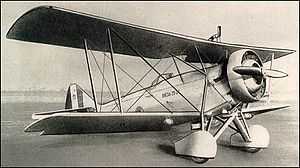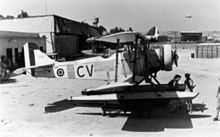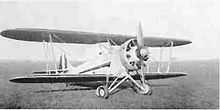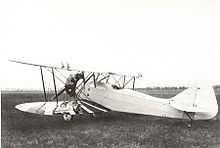Breda Ba.25
| Ba.25 | |
|---|---|
 | |
| Ba.25 | |
| Role | Trainer aircraft |
| Manufacturer | Società Italiana Ernesto Breda |
| First flight | 1931 |
| Introduction | 1932 |
| Primary users | Regia Aeronautica Royal Hungarian Air Force |
| Produced | 1931-1938 |
| Number built | 763 + 3 prototypes [1] |
|
| |

The Breda Ba.25 was an Italian two-seat biplane trainer designed and built by the Breda company. It was the most widely used Italian basic trainer of the 1930s.
Design and development
The first flight took place near Milan in 1931. Initially designed as a single-seat aircraft, the prototype was later converted to a two-seat fuselage. Flight testing of the two-seat variant was successful, and in late 1931 Regia Aeronautica ordered a series of 100 Ba.25 training aircraft. The student and instructor sat in open tandem cockpits, although some versions had a single-bay cockpit.
The initial production order was completed by 1935, but demand for the aircraft increased and production for the Regia Aeronautica totalled 719 by the end of 1938. Many others were produced for export or for private use with different radial engines like the Alfa Romeo Lynx or Walter Castor.
Operational history
The Ba.25 remained in service of the Regia Aeronautica as training aircraft during World War II. Some of the aircraft were seized and handed over to the Allies. Paraguay bought four Breda Ba.25, one of them Ba.25Idro. They were used as primary trainers from 1939 to 1945. [2] [3]
Variants




There were many minor variants:
- Ba.25
- Main production version.
- Ba.25/Lynx
- Fitted with a 149 kW (200 hp) Alfa Romeo Lynx engine.
- Ba.25/D.2
- Fitted with a 179 kW (240 hp) Alfa Romeo D2 engine.
- Ba.25/Mezzo-Asso
- Fitted with a 164 kW (220 hp) Isotta-Fraschini Asso 200 engine.
- Ba.25 Ridotto'
- Reduced-span aerobatic version.
- Ba.25-I (I for Idro)
- Floatplane version (42 built, one for Paraguayan Naval Aviation)
- Ba.26
- Primary trainer with a longer wingspan and Walter NZ 120 engine, prototype only.
- Ba.28
- Export version with Piaggio-built Gnome-Rhône 7K engine for Norway, China and Ethiopia, among others.
The Ba.28 training aircraft was developed from the earlier Ba.25. Also a biplane with a new, more powerful Piaggio Stella P.VII Z radial engine of 365 hp, had ailerons on the upper wing . In June 1936 the prototype was shown at the air show in Venice. The Italian Air Force in the same year ordered a series of 50 aircraft. During use in flight schools the Ba.28 proved not to be among the best - it was difficult to manage in the air. However, orders for the type arrived from abroad - were duly delivered to the following countries: Afghanistan (2), China (18), Norway (6), Austria (12) and Spain (6).
Operators
- Austrian Air Force (1927-1938)
- Royal Hungarian Air Force operated 3 aircraft
- Regia Aeronautica
- Aviazione Legionaria
- Italian Co-Belligerent Air Force
- Paraguayan Military Aviation used three Ba.25.
- Paraguayan Naval Aviation used one Ba.25 Idro.
Specifications (Ba.25)
Data from [4]
General characteristics
- Crew: 2
- Length: 7.80 m (25 ft 7 in) (Breda 25 Idro - 9.1 m (29.86 ft))
- Wingspan: 9.98 m (32 ft 9 in)
- Height: 2.8278 m (9 ft 3.33 in) (Breda 25 Idro - 3.6 m (11.81 ft))
- Wing area: 25.0 m2 (269 sq ft)
- Empty weight: 788 kg (1,738 lb)
- Gross weight: 2,288 kg (5,044 lb)
- Powerplant: 1 × Alia Romeo D2 9-cyl. air-cooled radial piston engine, 180 kW (240 hp)
Performance
- Maximum speed: 205 km/h (127 mph; 111 kn)
- Cruise speed: 195 km/h; 105 kn (121 mph) (Breda 25 Idro - 93 mph (150 km/h))
- Stall speed: 71 km/h; 38 kn (44 mph) (Breda 25 Idro - 56 mph (90 km/h))
- Range: 499 km; 269 nmi (310 mi)
- Service ceiling: 7,498 m (24,600 ft)
- Rate of climb: 2.87 m/s (565 ft/min) [5]
See also
- Aircraft of comparable role, configuration and era
- de Havilland Tiger Moth
- N3N Canary
- Yokosuka K5Y
- Related lists
Notes
- ↑
- ↑ Ba.25 entry at the Уголок неба website (Russian)
- ↑ "La Contribución Italiana en la Aviación Paraguaya" by Antonio Luis Sapienza. Author's edition. Asunción. 2007
- ↑ Thompson, Jonathan (1963). Italian Civil & Military Aircraft 1930-1945 (1st ed.). New York. ISBN 0-8168-6500-0.
- ↑ Grey, C.G. (1972). Jane's All the World's Aircraft 1938. London: David & Charles. ISBN 0-7153-5734-4.
References
External links
| Wikimedia Commons has media related to Breda Ba.25. |
| ||||||||||||||||||
| ||||||||||||||||||||||